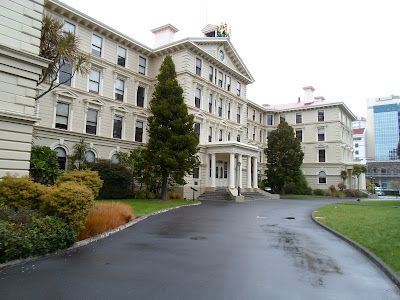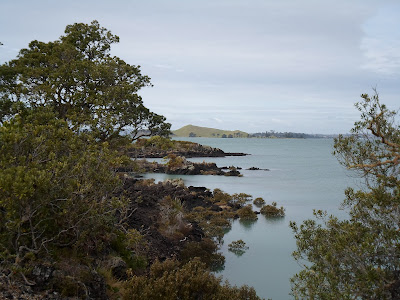At first I didn't look forward to Wellington. It's just a city, it's gonna be like Auckland i thought. I had to go to Wellington though because it's the only place where you can take a ferry to the South Island. So I was skeptic when I arrived but after half a day the city had won me over. Wellington is awesome. There are great coffee shops and great pubs everywhere, a lot of young and creative people hang around, so there is fashion, live music and street art on every corner and the city isn't totally filled with concrete like Auckland is. Wellington has forest belts around it's city center and they are there by design, not just because the hills are too steep to build suburbs on. Almost everywhere you go in Wellington you can see at least 1 forest ridge on the horizon. It just is the greatest capital in the world.
The first day I did a little city trip around the small city center and I went to check out all the big and old buildings. The old government building looks like a massive classical stone building but it's actually entirely made out of wood. When it was build in 1876 (that is very old to New-Zealand's standards) there just wasn't enough money to build it in stone. Now it is the second biggest wooden structure in the world and the first building ever to have an inside smoking ban. I also went for a tour of the current parliament complex. It exists of a modern building called the Beehive, a neoclassical house of parliament and a Victorian Gothic building that houses the parliamentary library. It is a weird combination of buildings and especially the Victorian Gothic style I've never seen before. It looks like they have let a gay hairdresser choose the paint for a Gothic church. Afterwards I went to old St-Paul's cathedral, a wooden church (again, no money to build it in stone) that's about 200 years old. They used native timber that has wonderfully darkened with age.
The second day I decided to release my inner-Hobbit again and I went to the Weta Caves, out in the suburbs of Wellington. Weta is the special effects company that worked on Lord of the Rings (but also Avatar, Tintin and the upcoming Halo movie) and their cave is marketed as a museum but it's actually just a shop full of movie collectibles. You can buy a miniature of Rivendel there but also an actual Orc sword, posters and books and of-course the ring. I was tempted to buy the one ring to rule them all, and in darkness bind them but those collectibles are very expensive. So I only bought a piece of chainmail. This chainmail is a Weta invention, it's made of plastic but it looks like real metal on screen. So it's light to wear and cheap to make when you have to dress 200 actors in it. In the afternoon I went movie location hunting again in the southern forest belt around Wellington. Scenes from the outer Shire were filmed over there and I spent 3 hours there but I just couldn't find them. When it began to get dark I gave up and went to the pub. There were local bands playing and one of them was actually pretty good.
My last day in Wellington I spend almost entirely in Te Papa, the national museum of New-Zealand. It's a very good museum. It tells the story of Aotearoa New-Zealand, all of it. It's about the native animals and plants, about the Maori and the pakeha settlers, about volcanoes and earthquakes but also about New-Zealand in more modern times. I learned that the first man on Mount Everest and the first guy to split the atom were Kiwi's. Funny actually that New-Zealand now is radically opposed to nuclear power. Very interesting and interactive, it has an earthquake room that simulates a 5.0 earthquake, you can play bio security officer, searching a container for pests that aren't allowed to enter the country, and you can make traditional Maori music by touching the right buttons in the right order (or make Maori dubstep by touching them in the wrong order, like I did). After about 6 hours in the museum I met up with Michael, a German backpacker I met in Gisborne and who just arrived in Wellington. He is even more Tolkien crazy then I am and with a doubled amount of persistence we went looking for the movie location and eventually found the exact spot where the Hobbits hid under a tree root when they first encounter the nazgul. How were we sure that we were on that exact spot you may ask. That is because we found a group of tourists on a guided movie tour and we spied on them a little.
After 3 days it was time to leave Wellington and go to the South Island. The first time in New-Zealand that I was sad to leave a place. I really liked Wellington and I could actually live in that city ... if it wasn't so damn expensive. It is probably best for my bank account and my heart (with all these home roasted coffee shops around I drank about 5 espresso's a day) that I left the city.
The first day I did a little city trip around the small city center and I went to check out all the big and old buildings. The old government building looks like a massive classical stone building but it's actually entirely made out of wood. When it was build in 1876 (that is very old to New-Zealand's standards) there just wasn't enough money to build it in stone. Now it is the second biggest wooden structure in the world and the first building ever to have an inside smoking ban. I also went for a tour of the current parliament complex. It exists of a modern building called the Beehive, a neoclassical house of parliament and a Victorian Gothic building that houses the parliamentary library. It is a weird combination of buildings and especially the Victorian Gothic style I've never seen before. It looks like they have let a gay hairdresser choose the paint for a Gothic church. Afterwards I went to old St-Paul's cathedral, a wooden church (again, no money to build it in stone) that's about 200 years old. They used native timber that has wonderfully darkened with age.
The second day I decided to release my inner-Hobbit again and I went to the Weta Caves, out in the suburbs of Wellington. Weta is the special effects company that worked on Lord of the Rings (but also Avatar, Tintin and the upcoming Halo movie) and their cave is marketed as a museum but it's actually just a shop full of movie collectibles. You can buy a miniature of Rivendel there but also an actual Orc sword, posters and books and of-course the ring. I was tempted to buy the one ring to rule them all, and in darkness bind them but those collectibles are very expensive. So I only bought a piece of chainmail. This chainmail is a Weta invention, it's made of plastic but it looks like real metal on screen. So it's light to wear and cheap to make when you have to dress 200 actors in it. In the afternoon I went movie location hunting again in the southern forest belt around Wellington. Scenes from the outer Shire were filmed over there and I spent 3 hours there but I just couldn't find them. When it began to get dark I gave up and went to the pub. There were local bands playing and one of them was actually pretty good.
My last day in Wellington I spend almost entirely in Te Papa, the national museum of New-Zealand. It's a very good museum. It tells the story of Aotearoa New-Zealand, all of it. It's about the native animals and plants, about the Maori and the pakeha settlers, about volcanoes and earthquakes but also about New-Zealand in more modern times. I learned that the first man on Mount Everest and the first guy to split the atom were Kiwi's. Funny actually that New-Zealand now is radically opposed to nuclear power. Very interesting and interactive, it has an earthquake room that simulates a 5.0 earthquake, you can play bio security officer, searching a container for pests that aren't allowed to enter the country, and you can make traditional Maori music by touching the right buttons in the right order (or make Maori dubstep by touching them in the wrong order, like I did). After about 6 hours in the museum I met up with Michael, a German backpacker I met in Gisborne and who just arrived in Wellington. He is even more Tolkien crazy then I am and with a doubled amount of persistence we went looking for the movie location and eventually found the exact spot where the Hobbits hid under a tree root when they first encounter the nazgul. How were we sure that we were on that exact spot you may ask. That is because we found a group of tourists on a guided movie tour and we spied on them a little.
After 3 days it was time to leave Wellington and go to the South Island. The first time in New-Zealand that I was sad to leave a place. I really liked Wellington and I could actually live in that city ... if it wasn't so damn expensive. It is probably best for my bank account and my heart (with all these home roasted coffee shops around I drank about 5 espresso's a day) that I left the city.
The old government building: 100% wood
The parliamentary library
Legolas weapons on display in the Weta Cave
The tree the hobbits hide under only excists on Peter Jackson's computer but all the rest is still there
Street art in Wellington
The closest I will probably get to a Kakapo. In the endangered species section of Te Papa












































